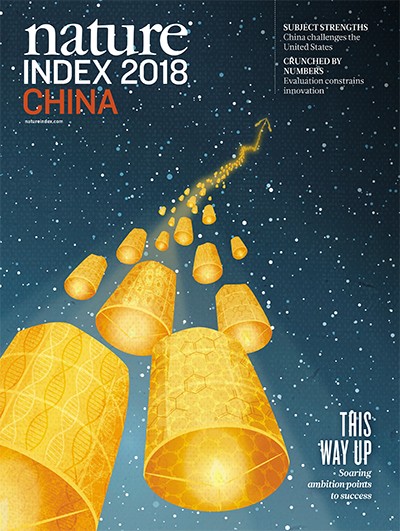
A scientist working in a laboratory in Zhengzhou, China.Credit: He Zi Qing/EyeEm/Getty
China’s rise is the story of the century in science. The news this year that China surpassed the United States as the world’s largest producer of scientific articles in 2016 should have come as no surprise. Scientific research is central to President Xi Jinping’s dream of China becoming an innovation-driven, knowledge-led economy by 2050.
But despite a 75% rise since 2012, China remains a distant second to the US in its overall output in the Nature Index. This suggests it still has a way to go on research quality, because the Nature Index measures the relative contribution of authors to articles published in 82 natural science journals, chosen by a panel of experts as the world’s best.
This supplement focusses on selected disciplines that are leading the way to overcoming China’s scientific quality deficit. Notably, China is already at, or very near the top of the index rankings in chemistry and plant biology, two areas in which it has arguably the richest research tradition. The story of biomedical engineering shows the country adapting to international standards on the path towards global science leadership, while the cases of astronomy and nanotechnology highlight its willingness to invest the necessary resources.
There are many problems yet to solve, though, if the dream is to become reality. As a recent survey of Chinese academics highlights, and Futao Huang further explains, a fixation on instant success, job insecurity, and the demands of bureaucracy are among hindrances in the research environment to the flourishing of innovative practice.


 Ongoing challenge
Ongoing challenge
 Yielding results to feed a people
Yielding results to feed a people
 China’s place among the stars
China’s place among the stars
 Small science grows large in new hands
Small science grows large in new hands
 Engineering a biomedical revolution
Engineering a biomedical revolution
 Strong spending compounds chemistry prowess
Strong spending compounds chemistry prowess
 Quality deficit belies the hype
Quality deficit belies the hype
 Citations strength begins at home
Citations strength begins at home
 Partner content: Make your mark in the city of makers
Partner content: Make your mark in the city of makers
 Partner content: A non-stop route to collaborative discovery
Partner content: A non-stop route to collaborative discovery
 Partner content: Melbourne, Victoria — Number 1 in Australia for medical research and biotechnology
Partner content: Melbourne, Victoria — Number 1 in Australia for medical research and biotechnology





